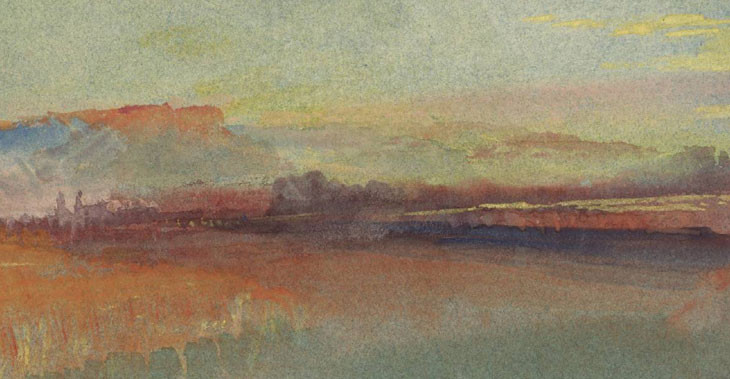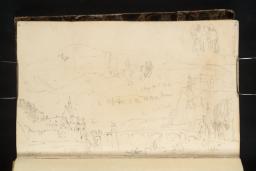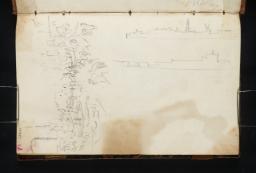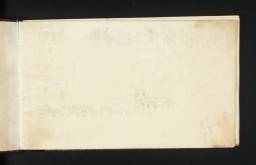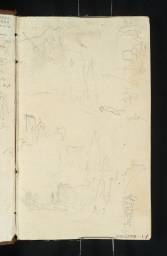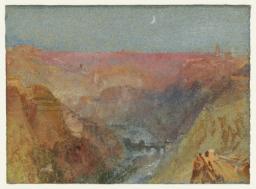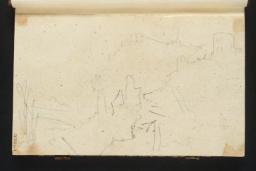The Second Meuse-Moselle Tour 1839
From the entry
On Friday 2nd August 1839 Turner wrote to a fellow Royal Academy painter H.W. Pickersgill (1782–1875) to inform him that he would need to decline an invitation to meet the following day. Turner would be ‘on the Wing for the continent’, as he put it, beginning a sketching tour of Belgium, north-eastern France, western Germany and Luxembourg. The purpose: to record, for the second time, the Meuse, Moselle (or Mosel, as it is known in Germany) and Rhine Rivers and their varied picturesque and historically significant plains and valleys. Turner had previously studied the Meuse and Rhine Rivers in 1817, eventually recording the Meuse, Moselle and Rhine in 1824. The sketches of this 1839 tour, however, show that artist intended to study the rivers in even greater detail and from a greater diversity of viewpoints than before, sketching from the water, the shore and also from inland. The artist returned to places he had visited in 1824, such as Huy and Dinant in Belgium, but also took excursions and ...
Givet, Mézières, Verdun, Metz, Luxembourg and Trèves Sketchbook
D28167–D28290; D41087–D41089
Turner Bequest CCLXXXVIII 1–68a
D28167–D28290; D41087–D41089
Turner Bequest CCLXXXVIII 1–68a
Trèves to Cochem and Coblenz to Mayence Sketchbook
D28351–D28412; D28415–D28516; D28520–D28537; D41203–D41205
Turner Bequest CCXC 1–91a
D28351–D28412; D28415–D28516; D28520–D28537; D41203–D41205
Turner Bequest CCXC 1–91a
Meuse-Moselle Gouache and Watercolour Drawings
D20221–D20223, D20226–D20229, D20230, D20233, D20234, D20237–D20240, D20244–D20249, D20253, D20254, D20259, D20261–D20264, D20266–D20273, D20275, D20277, D20280, D20283–D20286, D20288, D20289, D24578, D24588–D24590, D24610, D24634, D24664, D24709, D24711, D24715–D24717, D24723–D24725, D24731, D24732, D24735, D24736, D24741, D24742, D24745, D24753, D24780, D24782, D24784, D24788, D24789, D24804, D24806, D24809, D24823, D24833, D28986, D29017, D29021, D29023, D29029
Turner Bequest CCXX N–CCXX P, CCXX S–CCXX V, CCXX W, CCXX Z, CCXXI A, CCXXI D–G, CCXXI K–CCXXI P, CCXXI T, CCXXI U, CCXXI Z, CCXXII B–E, CCXXII G– CCXXII N, CCXXII P, CCXXII R, CCXXII U, CCXXII X–CCXXIII A, CCXXIII C, CCXXIII D, CCLIX 13, CCLIX 23–CCLIX 25, CCLIX 45, CCLIX 69, CCLIX 99, CCLIX 144, CCLIX 146, CCLIX 150–CCLIX 152, CCLIX 159, CCLIX 160, CCLIX 166, CCLIX 167, CCLIX 170, CCLIX 171, CCLIX 176, CCLIX 177, CCLIX 180, CCLIX 188, CCLIX 215, CCLIX 217, CCLIX 219, CCLIX 223, CCLIX 224, CCLIX 239, CCLIX 241, CCLIX 244, CCLIX 258, CLIX 268, CCXCII 39, CCXCII 66, CCXCII 70, CCXCII 72, CCXCII 78
D20221–D20223, D20226–D20229, D20230, D20233, D20234, D20237–D20240, D20244–D20249, D20253, D20254, D20259, D20261–D20264, D20266–D20273, D20275, D20277, D20280, D20283–D20286, D20288, D20289, D24578, D24588–D24590, D24610, D24634, D24664, D24709, D24711, D24715–D24717, D24723–D24725, D24731, D24732, D24735, D24736, D24741, D24742, D24745, D24753, D24780, D24782, D24784, D24788, D24789, D24804, D24806, D24809, D24823, D24833, D28986, D29017, D29021, D29023, D29029
Turner Bequest CCXX N–CCXX P, CCXX S–CCXX V, CCXX W, CCXX Z, CCXXI A, CCXXI D–G, CCXXI K–CCXXI P, CCXXI T, CCXXI U, CCXXI Z, CCXXII B–E, CCXXII G– CCXXII N, CCXXII P, CCXXII R, CCXXII U, CCXXII X–CCXXIII A, CCXXIII C, CCXXIII D, CCLIX 13, CCLIX 23–CCLIX 25, CCLIX 45, CCLIX 69, CCLIX 99, CCLIX 144, CCLIX 146, CCLIX 150–CCLIX 152, CCLIX 159, CCLIX 160, CCLIX 166, CCLIX 167, CCLIX 170, CCLIX 171, CCLIX 176, CCLIX 177, CCLIX 180, CCLIX 188, CCLIX 215, CCLIX 217, CCLIX 219, CCLIX 223, CCLIX 224, CCLIX 239, CCLIX 241, CCLIX 244, CCLIX 258, CLIX 268, CCXCII 39, CCXCII 66, CCXCII 70, CCXCII 72, CCXCII 78
On Friday 2nd August 1839 Turner wrote to a fellow Royal Academy painter H.W. Pickersgill (1782–1875) to inform him that he would need to decline an invitation to meet the following day. 1 Turner would be ‘on the Wing for the continent’, as he put it, beginning a sketching tour of Belgium, north-eastern France, western Germany and Luxembourg. The purpose: to record, for the second time, the Meuse, Moselle (or Mosel, as it is known in Germany) and Rhine Rivers and their varied picturesque and historically significant plains and valleys.
Turner had previously studied the Meuse and Rhine Rivers in 1817, eventually recording the Meuse, Moselle and Rhine in 1824. The sketches of this 1839 tour, however, show that artist intended to study the rivers in even greater detail and from a greater diversity of viewpoints than before, sketching from the water, the shore and also from inland. The artist returned to places he had visited in 1824, such as Huy and Dinant in Belgium, but also took excursions and detours to places he had not, such as Spa, Franchimont, and Mayence. In addition, he took several days to study specific locations in depth; this approach is particularly evident in the sketches of the Duchy of Luxembourg (CCLXXXVIII). In all, it is the energy and fervour with which Turner explored the region that characterises and separates the tour of 1839 from the others. Indeed, as the Turner scholar Cecilia Powell writes, ‘whereas in 1824’ the artist ‘travelled largely by river’ and rarely went ‘off the beaten track, fifteen years later he behaved with all the independence and inquisitiveness of a youthful adventurer’.2
The 1839 tour is revealed in all its complexity in a group of five sketchbooks. They are: the Spa, Dinant and Namur, the Givet, Mézières, Verdun, Metz, Luxembourg and Trèves, the First Mossel and Oxford, the Trèves to Cochem and Coblenz to Mayence, and the Cochem to Coblenz – Home sketchbooks. Turner himself listed all five as a group, in the order they appear above, on a paper label affixed to the cover of one of the sketchbooks. 3 The label provides a synopsis of the tour and an idea of its chronology. Turner also inscribed each fore-edge of the sketchbooks with short vertical lines: a single line for the first book, two lines for the second and so on.4
With the exception of the First Mossel and Oxford sketchbook, all are small, upright books of near identical dimensions bound in boards covered with marbled paper. This was a form of binding ‘used on the Continent throughout the nineteenth century’, according to Powell, ‘both for books of blank paper and for a wide variety of printed books’.5 Turner also took with him a partially used and much larger horizontal-format sketchbook from England, which already contained full and double-page panoramic drawings of the city of Oxford.6 Turner would title this book the First Mossel and Oxford (CCLXXXIX), as the remaining pages and spaces around the Oxford drawings were filled with small and hastily rendered sketches of the Moselle.
The five sketchbooks form a pictorial and textual memorandum of the tour, the pages of each comprised of swift jottings, more considered and sometimes squared-off compositions, and written notes recording the lay of the land or the quality of light. The majority of the Meuse scenes depict Belgian views: the city of Liège, the fortress towns of Huy and Namur, the vertiginous cliffs and oolitic rock formations of the Meuse valley, the sights in and around Dinant, and the mineral springs at Spa. Among the French subjects are depictions of the lush Ardennes mountain range, the Fort Charlemont at Givet, and the walled city of Metz with its resplendent Gothic cathedral. The Moselle and Rhine views equally encompass defensive fortresses and citadels, such as Koblenz’ Ehrenbreitstein, but also contain sketches of the region’s innumerable medieval castles (such as the Burg Bischofstein, Rheinfels, Lahneck and Stolzenfels) which are often picturesquely ruined and almost always rather miraculously perched atop a lofty precipice. Turner also sketched the ancient roman city of Trèves or Trier, recording sights such as the Porta Nigra, the Römerbrücke, and the Aula Palatina or Constantine Basilica. This brief synopsis only constitutes a selection of Turner’s 1839 subjects. The stages of the tour are described in more detail in the Itinerary text below.
From the material gathered in these five sketchbooks, an entirely new body of work emerged following Turner’s return to England at the end of September.7 As was the artist’s general practice, a selection of the sketches belonging to the summer expedition were developed into a series of finished works during the winter months. The 1839 tour inspired over one hundred colour drawings, all executed in gouache, watercolour and pen and ink on blue paper. Of those in the Turner Bequest over twenty depict the Meuse, about forty the Moselle, and some twenty are of the city of Luxembourg alone. A further twenty or so works are held elsewhere or in private collections. The drawings are celebrated for their brilliant chromatic range, technical dexterity, and display of atmospheric effect. They show Turner’s facility in evoking aspects of the landscape not easily made material, such as the misty vapour rising from the gorges of Luxembourg or the warm glow of a balmy summer’s evening.
The gouaches possess common stylistic traits which suggest, as Cecilia Powell writes, ‘that they were produced in batches of up to perhaps ten or so at a time’ and therefore not before the motif.8 There is also no evidence to suggest that Turner employed different stylistic techniques to differentiate, for example, Rhenish from Moselle subjects. Several of the Meuse scenes resemble the Moselle or Luxembourg in their handling and colouring whilst others are noted for their pen drawing, a characteristic ‘rare in the German scenes’.9
The palette and technique of the 1839 gouaches is attributable, Powell has suggested, to ‘highly significant developments’ in Turner’s career ‘since 1817’.10 Here Powell refers to two extended visits to Italy in 1819 and 1828 where the artist’s colouring became noticeably ‘lighter, brighter, and more various’.11 In addition, Turner had experimented with gouache on blue paper in two other large series: the first, in drawings depicting Petworth House in Sussex in the late 1820s; the second, in early 1830s designs of the Seine and Loire Rivers produced for engraving in volumes which have become known as the Rivers of France (1832–5) but were originally entitled Turner’s Annual Tour.12 Unlike the second project, the Meuse-Mosel gouaches were never engraved or published and remained in Turner’s possession until their incorporation into the Turner Bequest.13
No evidence has emerged to shed light on a specific commercial project for the 1839 drawings, which rather leaves Turner’s rationale for embarking on this extensive and complex tour unexplained. It may simply be that the artist travelled the three rivers for his own pleasure and curiosity. Or, as Cecilia Powell has speculated, there may have been thoughts of reviving the Annual Tour engraving project, given that advertisements led readers to believe that the series would eventually encompass the ‘Great Rivers of Europe’ and ‘River Scenery of Europe’.14 No further volumes of the Annual Tour, however, were ever issued.15
What is certain is that Turner maintained a longstanding interest in rivers and fluvial landscapes throughout his career, making both the principal subject matter of a number of paintings, watercolours and popular engraving projects such as The Rivers of England (1822–5) and Picturesque Views in England and Wales (1825–38).16 It is also clear that he regarded the Meuse, the Rhine and its chief tributary the Moselle with affection. Given that this was his third substantial tour of the region, Turner evidently derived pleasure and inspiration from this part of northern Europe. It is a pity, nonetheless, that we cannot be more specific about the possible motivations, financial or otherwise, for that summer’s tour.
This said, Turner may have ventured on the second tour with rather more speculative motivations. It is true that in the late 1830s there was a noticeable broadening of interest among British artists and illustrators in this region, and, a willing audience for their images. Artists such as Thomas Allom, Thomas Shotter Boys, and W.H. Bartlett produced designs of the three rivers for engraving, as did Clarkson Stanfield, whose Sketches on the Moselle, the Rhine, & the Meuse was published in 1838.17 George Arnald’s Picturesque Scenery on the River Meuse, also went into a second edition in 1838 after having been first published in 1828. A market for images of northern European river landscapes was clearly in place: the products appealed to subscribers certainly for their decorative quality but also because the topographies depicted were themselves relevant and historically meaningful to nineteenth-century British audiences.
The Meuse, Moselle and middle Rhine were recognised as the channels through which well-known and bloody battles had been fought, territories had been won, communities had been forged and destroyed, and through which economies had flourished and waned. Owing to their strategic significance, the three rivers played a crucial role in the political, economic, social and cultural transformations of much of northern Europe, a number of these occurring as recently as in Turner’s lifetime.
From the Roman occupation and throughout the medieval period, the rivers were embedded in continual territorial battles fought between local tribes, noble houses and archbishoprics: their valleys apportioned into domains defended by numerous citadels, fortifications, castles, and tolling stations. From the sixteen to the nineteenth centuries, the region was of great strategic importance and was often at the frontline of brutal and extended military campaigns fought by and between French, Netherlandish, Prussian and English armies. Parts of the Thirty Years’ War (1618–48); the Nine Years’ War (1688–97); and, in Turner’s lifetime, the French Revolutionary Wars (1792–1802), and the Napoleonic Wars (1803–15) had been fought along the banks of the Meuse, Moselle, and Rhine. By the time of the artist’s visit in 1839, it had only been four months since Belgium had secured independence from the Netherlands after years of tension following the signing of the Treaty of London. It is no surprise then that the region was replete with fully functioning artillery barracks and citadels as well as the ruins of medieval strongholds overlooking the valleys below them.
Such military and defensive architecture is at the heart of Turner’s 1839 pencil sketches and gouache drawings. These landmarks were entrenched in the region’s historical and political narrative and, no doubt, would have been of interest to curious audiences back in England. Should the gouaches have been published, they might have been accompanied by some descriptive text, recalling to viewers the stories, myths and legends of this complex region as a form of virtual tourism. As Cecilia Powell writes, ‘in the days before photography, the cinema, television and videos... Turner’s public ‘had an almost insatiable demand for written descriptions and images of natural scenery’ and historical landmarks ‘near or far’.18
For those individuals with an interest in actually visiting the Meuse-Mosel and Rhine, the path to this part of the Continent was, by 1839, reasonably well trod. With the advent of guidebooks such as those by John Murray, northern Europe was marketed as a beautiful, genteel, and accessible destination rich in historical and literary associations.19
For example, Bartholomew Stritch, Irishman and London editor of The Germanic Review, wrote of the ‘very considerable number of English travellers, who every summer go up the Rhine, and sojourn...at the German Spas and Watering places’.20 The diversion of taking the ‘Moselle route to the Rhine’ would reward the traveller with ‘a greater variety of beautiful and imposing scenery’ and ‘the advantage of beholding some of the most interesting remains of Roman architecture existing north of the Alps’.21 To those, continues Stritch, who are ‘set free, by the long vacation’ and are able to explore all three of the rivers, ‘no more delightful or rational manner of spending their time or their money can be offered’ in excursions ‘combining novelty of sensation, observation of foreign scenery and manners, contemplations of Roman, Gothic and feudal remains, with a near glance at continental society up to its highest summits’.22 Meanwhile, the Meuse, to the journalist and novelist Dudley Costello, possessed ‘beauties of its own, which will amply reward all who seek them; that its history, its language, its customs, and its traditions, are replete with interest; and the lover of nature, and the inquirer into the past, may alike find food for admiration and refection as he wanders between its banks’.23 Costello’s account revealed the valley of the Meuse as a place rich in myth and legend, his text filled with tales of medieval Teutonic knights and their maidens popular with contemporary audiences.
An English readership may also have been familiar with poetical accounts of the landscapes and legends of the Meuse, Moselle and Rhine from Byron’s Childe Harold’s Pilgrimage (1812–18) or Wordsworth’s ‘Scenery between Namur and Liège’ from Memorials of a Tour on the Continent (1822), which includes a lyrical homage to the Meuse and its histories:
What lovelier home could gentle Fancy choose?
Is this the stream, whose cities, heights, and plains,
War’s favourite playground, are with crimson stains
Familiar, as the Morn with pearly dews?
The Morn, that now, along the silver meuse,
Spreading her peaceful ensigns, calls the swains
To tend their silent boats and ringing wains
[...] As mine eyes,
Turn from the fortified and threatening hill,
How sweet the prospect of yon watery glade,
With its grey rocks clustering in pensive shade –
That, shaped like old monastic turrets, rise
From the smooth meadow-ground, serene and still!24
Other relevant publications included Joseph Snowe’s two-volume illustrative compendium, The Rhine, Legends, Traditions, History, from Cologne to Mainz (1839) and Edward Bulwer-Lytton’s poetical story Pilgrims of the Rhine (1834, with topographical illustrations by David Roberts). Turner himself was commissioned to produce vignettes to illustrate poems on Rhenish subjects in the 1830s, among them: Bachrach, On the Rhine as a frontispiece to Volume VIII of the Works of Lord Byron of 1832 (Tate impression T06648); Brussels–Distant View, a frontispiece to Volume V of The Prose Works of Sir Walter Scott, Bart. of 1834 (Tate impression T04729); and Rolandseck, a vignette for an edition of Thomas Campbell’s Poetical Works of 1837 (Tate impression T04779).25
Itinerary:
The Meuse from Liège up to Sedan
This section concerns the first leg of Turner’s 1839 tour: his journey through Belgium, Luxembourg and France’s north-eastern borders on the River Meuse. Preliminary pencil sketches are recorded in the Spa, Dinant, and Namur and the Givet, Mézières, Verdun, Metz, Luxemburg and Trèves sketchbooks, from which a series of gouache and watercolour drawings were produced.
On Saturday 3rd August, Turner set off for Brussels with the intent to make directly for Liège. It is tempting to suggest, as Powell writes, that he travelled by the General Steam Navigation Company’s steam yacht, the Earl of Liverpool, which is recorded to have left London for Brussels via Ostend on that very Saturday.26 Having arrived at the Belgian capital, the artist, it appears, proceeded to visit a stationer on the Rue de Madeleine to purchase a sketchbook which he would use to record his first visits to Spa, Dinant, Namur and their surrounding towns. Early pencil jottings in this book indicate that Turner then made for Brussels’ town square where the diligence stagecoaches were caught bound for the east. Whilst waiting for his coach he made a swift and summary sketch of the lively scene before him (Tate D28044; Turner Bequest CCLXXXVII 2). This was later developed into a gouache drawing capturing the bustle of Brussels’ main thoroughfare and the flurry of passengers mounting and dismounting the coach with their luggage (Tate D24784; Turner Bequest CCLIX 219).
It is believed that Turner’s next stop was the city of Louvain (Leuven), a short distance north of Liège. There he made sketches of the celebrated St Peter’s Church and the Town Hall, both of Brabantine Late Gothic style and carved with ornate, lace-like decoration (Tate D28045, D28047; Turner Bequest CCLXXXVII 2a, 3a). These detailed pencil drawings were also developed in gouache, executed in similar style and colouring to the Brussels drawings (Tate D20263, D24590; Turner Bequest CCXXII D, CCLIX 25). Upon reaching Liège, it is thought that Turner made a detour to Spa, a town nestled in the Ardennes mountain range some twenty miles to the south-east and famed for its healing mineral springs. However, as Cecilia Powell writes, Turner may well have also ‘stayed a night at Liège, in order to break his journey, which enabled him to perambulate around the city making a handful of sketches of some of its principal sights such as the Pont des Arches’ (Tate D28066, D28068, D28070–D28073, D28076; Turner Bequest CCLXXXVII 13, 14, 15–16a, 18).27
At Spa Turner sketched all of the main springs of the town and in the surrounding hillsides such as the Géronstère, the Groesbeck and Sauvenière (Tate D28077–D28092; Turner Bequest CCLXXXVII 18a–26). The resorts were popular with genteel ladies and gentlemen visiting from England and the Continent. They came to take the health-giving waters, to enjoy leisurely perambulations through the woods and leafy promenades, and to experience Spa’s congenial society. Turner produced six gouache drawings from the plethora of sketches taken here (Tate D24610, D24745, D24753, D24780, D24788, D29017; Turner Bequest CCLIX 45, 180, 188, 215, 223, CCXCII 66).
Turner then visited the ruins of the medieval castle of Franchimont and the neighbouring hamlet of Marché de Theux, located close to Spa off the Liège road. The castle features in about a dozen pencil sketches, ‘from the moment it first came into sight until it disappeared from view’ (Tate D28093, D28095–D28104; Turner Bequest CCLXXXVIII 27, 28–33).28 A number of these sketches formed the basis of further gouache drawings (Tate D20266, D20269, D20289, D24732; Turner Bequest CCXXII G, CCXXII J, CCXXIII D, CCLIX 167). From Franchimont Turner travelled back to Liège, following the path of the Meuse past Seraing to Chokier in order to sketch its celebrated and grandiose eighteenth-century chateau. He then made for the abbey at Flône, founded in 1075 and for centuries associated with the Augustinian order.29
Moving south, and continuing along the trajectory of the Meuse towards France, Turner journeyed to the fortified towns of Huy, Namur and Dinant. Given their locations along the Meuse, each held enormous strategic value and were home to monumental citadels. Huy and Dinant’s were constructed by the Dutch between 1819 and 1821 whilst the French King Louis XIV engaged Sébastien Le Prestre de Vauban, his celebrated military engineer, to construct a fortress at Namur during the invasion of 1692.30 Each built to dominate these communities from on high, the citadels, in the minds of the townspeople, were potent symbols of military control and their own political and civic unrest right up to, and probably beyond, the Belgian Revolution of 1830–1.
Turner continued to travel the Meuse making further sketches of Huy, Namur, and Dinant, and recording the magnificent ecclesiastical buildings, geological landmarks and ancient chateaux which abounded there. Those documented by the artist include the collegiate churches of Notre-Dame at Dinant and Huy, the Cathedral of St Aubin at Namur, Dinant’s gigantic monolith, the Rocher Bayard, and the castles of Poilvache, Crèvecoeur and Marche-les-Dames (see Tate D20221, D20222, D20226–D20229, D20262, D20268, D20286, D20288, D24711, D24716, D24724; Turner Bequest CCXX N, CCXX O, CCXX S–CCXX V, CCXXII C, CCXXII I, CCXXIII A, CCXXIII C, CCLIX 146, 151, 159).
Turner then crossed into north-eastern France, recording this leg of the tour in the Givet, Mézières, Verdun, Metz, Luxemburg and Trèves sketchbook. His drawings of the Meuse and French Ardennes begin with Givet, a town presided over by the fourteenth-century Fort Charlemont (Tate D28170–D28177, D28180–D28185, D28187; Turner Bequest CCLXXXVIII 2a–6, 7a–10, 11). The Emperor Charles V had established the fortress in 1555 as a defence against the French until Givet was formerly ceded to Louis XVI in 1699.31 By the time of Turner’s visit, Givet was being popularised in novels about the Napoleonic Wars, such as Captain Frederick Marryat’s Peter Simple (1834) whose protagonist is imprisoned in Fort Charlemont and makes a bold getaway across the Meuse and Ardennes forests.
After his stint at Givet, Turner visited the two adjacent communities of Mézières and Charleville (merged in 1966 to create Charleville-Mézières) to sketch the picturesque Church of Notre-Dame d’Espérance, the Pont d’Arche, the Porte de St Julien, and the Tours d’École and Militaire (Tate D28190–D28199, D28201, D28204; Turner Bequest CCLXXXVIII 12a–17, 18, 19a). From there the artist recorded views at Sedan and Verdun, both fortified with citadels by Vauban, before stopping at the ancient city of Metz, located at the confluence of the Moselle and Seille Rivers. Its ecclesiastical buildings, such as the Gothic Cathedral of St Etienne and Church of St Vincent, and its extensive network of fortifications dating from classical antiquity provided Turner with fruitful sketching grounds (Tate D28200, D28216–D28219, D28221, D28222; Turner Bequest CCLXXXVIII 17a, 25a–27, 28, 28a).
The duchy of Luxembourg appears to have been Turner’s penultimate destination. It was, as Cecilia Powell writes, ‘universally regarded...as the grandest fortress town in northern Europe – “the Gibraltar of the North”’.32 Standing at the confluence of the Alzette and Pétrusse Rivers, part of the city is built atop precipitous sandstone cliffs that drop into the rivers’ narrow valleys and deep gorges. Other districts are set on different levels, straddling hills and clinging precariously onto gradients. In all, Luxembourg City afforded Turner a multitude of arresting views, spectacular natural grandeur and some exhilarating sketching expeditions.
There are nearly thirty pencil drawings of Luxembourg in the Givet, Mézières, Verdun, Metz, Luxemburg and Trèves sketchbook (Tate D28228–D28231, D28266–D28288; Turner Bequest CCLXXXVIII 32a–34, 56a–67a). From these Turner produced over twenty colour drawings, the greatest number of gouaches in the series devoted to a single town. The beauty of the city notwithstanding, Powell suggests that Turner also may have been inspired to direct his attention towards Luxembourg because it was at the time being heavily reported in broadsheets and popular print.33 In 1839, a treaty was signed between The Netherlands and the Kingdom of Belgium to secure the independence and neutrality of Belgium and re-establish the frontiers of the Grand Duchy and of Luxembourg’s territories as a whole.34 Hence, ‘after a lifetime of supplying whatever topographical views were dictated by current fashion’, Powell writes, ‘Turner would not have neglected the opportunity of studying places that were in the news, were likely to be increasingly visited and could profitably be depicted in future’.35 None of the 1839 colour drawings, however, was ever engraved or published. For the Luxembourg gouaches, then, see Tate D20244–D20249, D20264, D20270, D20272, D20273, D20284, D20285, D24742; Turner Bequest CCXXI K–P, CCXXII E, CCXXII K, CCXXII M, CCXXII N, CCXXII Y, CCXXII Z, CCLIX 177.
After a productive stay in Luxembourg, Turner proceeded to the German city of Trier (Trèves), just under forty miles to the north. Here he largely surveyed and sketched the city from across the Moselle at Pallien, a town which afforded him the greatest number of vantage points of Trier’s topography and sites of antiquarian and ecclesiastical interest. These include: the Porta Nigra, the ruins of the Imperial Baths, the Basilica, the Roman Bridge, the Cathedral of St Peter and the neighbouring Liebfrauenkirche and finally St Gangolf’s Church (Tate D28186, D28203, D28206, D28207, D28244, D28246, D28249, D28250, D28256, D28258–D28260, D28263, D28264; Turner Bequest CCLXXXVIII 10a, 19, 20a, 21, 42a, 43a, 45a, 46, 50, 51–52, 54a, 55). The related gouaches are: Tate D24715, D24741; Turner Bequest CCLIX 150, 176.
The Moselle and Rhine from Trier down to Koblenz
From Trier, Turner headed further into Germany, descending the Moselle for Koblenz. This leg of the tour is recorded in three further sketchbooks: the First Mosel and Oxford; Trèves to Cochem and Coblenz to Mayence; and Cochem to Coblenz–Home (Turner Bequest CCLXXXIX; CCXC; CCXCI).
Situated at the confluence of the Moselle and Rhine Rivers, Koblenz was home to the Festung Ehrenbreitstein, a vast fortress known also in English as the ‘broad stone of honour’ and the focus of many of Turner’s sketches. Dominating a lofty mountain on the east bank of the Rhine opposite Koblenz, the citadel was constructed by the Prussians between 1817 and 1832 as their chief military base within a network of regional fortifications.36 Ehrenbreitstein and its large garrison played a vital role in the Prussian defences against France. The strategic position of the fortress also enabled all means of transportation to and from the town to be tightly controlled and taxes to be levied. Turner recorded Ehrenbreitstein on a number of occasions in the First Mosel and Oxford; Trèves to Cochem and Coblenz to Mayence; and Cochem to Coblenz – Home sketchbooks. Particularly striking amongst these is the double-page and highly finished study of Ehrenbreitstein (Tate D28302–D28303; Turner Bequest CCLXXXIX 6a–7) which is meticulous in its rendering of detail and also the largest single sketch Turner produced on his 1839 tour.
The artist then doubled back up the Moselle, heading in the direction of Trier, so as to study the river in more depth and from the land. His route incorporated sketching excursions to an array of ancient castles, the majority of them the estates of medieval counts or Archbishops. These included the ‘ivy mantled ruins’ of the Burg Thurandt at Alken, located ‘on the summit of a high mountain’ (see Tate D28572–D28572; Turner Bequest CCXCI 18–18a and the gouaches Tate D20223, D29023; Turner Bequest CCXX P, CCXCII 72) and the Burg Bischofstein (Tate D29021; Turner Bequest CCXCII 70).37 Beilstein, a village ‘nestled at the foot of a rock’, was presided over by the Burg Metternich. It was comprised of ‘the ruins of a round tower, and a set of fortifications, surmounted by a square donjon keep’.38 Burg Metternich, for the traveller and novelist Michael Joseph Quin, constituted ‘one of the most picturesque memorials of chivalry to be seen on the Moselle’ (see Tate D20239, D28367–D28369; Turner Bequest CCXXI F, CCXC 9–10).39
D28550, D29029; Turner Bequest CCXXI D, CCXCI 7 a, CCXCII 78); the ruins of the monastery at Wolf (Tate D24717; Turner Bequest CCLIX 152) the Hermitage on the precipitous Michaelslei at Ürzig (D24789; Turner Bequest CCLIX 224); and the iron forges at Quint (Tate D24823; Turner Bequest CCLIX 258). The artist also took a large number of views at Trarbach and its sister town, Traben (see Tate D28308, D28310D28390–D28395, D28400–D28401; Turner Bequest CCLXXXIX 9a, 10a, CCXC 20a–23, 25a–26) from which he made four gouache drawings (Tate D20223, D20234, D20240, D20259; Turner Bequest CCXX P, CCXXI A G, Z).
Cecilia Powell has suggested that Turner may have based himself at Cochem for some time to undertake sketching tours up and down the Moselle. 40 He had done so in 1824, and that base would have provided the artist with the means to make a good number of peregrinations back and forth at leisure. This may explain why Turner filled the final three sketchbooks with such a multiplicity of jottings, sketches and studies which constitute ‘minute by minute’ and often repeated records of journeys. Quin lyrically describes Cochem as a town ‘seated at the base of two hills of the sugar-loaf shape... surmounted by the ruins of ancient castles’ and surrounded by ‘piles of mountains’ some ‘descending in waving lines until they are lost in the azure distance’.41 It is probably because of its beauty, then, that Turner produced the largest number of gouaches of Cochem of any Moselle town (Tate D20238, D20253, D24723, D24725, D24806, D28986; Turner Bequest CCXXI E, T, CCLIX 158, 160, 241, CCXCII 39). These works feature the ancient Reichsburg Castle, which stands overlooking the Moselle ‘upon a plateau of rock’, and its ‘bleached battlements, when illumined by the sun, shine out with the lustre of burnished steel armour’.42 Also depicted is the lofty tower of St Martin’s Church and the old Capuchin monastery.
Travelling the course of the Rhine from Koblenz provided Turner with equally ample subject matter. The artist passed by St Goar and its sister town St Goarhausen, each presided over by the Burg Rheinfels and Burg Katz (Tate D28455–D28457, D28506, D28507, D28509, D28510; Turner Bequest CCXC 53–54, 78a, 79a, 79c, 79d). Upon leaving St Goarhausen, Turner recorded the Lorelei, a soaring ridge steeped in legend on the eastern bank of the Rhine. He then stopped at the historic town of Oberwesel where the Gothic Pfarrkirche Liebfrauen and St Michael’s parish church stand, overlooked by the monumental and once Imperial Schönburg Castle. The town is encircled by medieval walls and an imposing series of towers, such as the cylindrical and crenellated Ochsenturm (Ox-Tower). Turner recorded all of these landmarks in the fourth 1839 sketchbook (Tate D28470, D28483–D28485, D28487–D28491, D28497, D28500, D28501; CCXC 60a, 67–68, 69–71, 74, 75a, 76), eventually producing a remarkable and highly finished watercolour from these preliminary pencil sketches in 1840.43
At the ancient city of Mainz (Mayence) the artist recorded the resplendent St Martin’s Cathedral, the series of defensive gate towers which circuit the city, the church of St Stephan and the statue of Johannes Gutenberg, the inventor of the mechanical moveable type printing press (Tate D28483–D28487; CCXC 67–9). From Mainz Turner made for Wiesbaden, a town just to the north, celebrated for its thermal springs and spas (Tate D28476; Turner Bequest CCXC 63 a).
Beginning his journey home to England, Turner travelled back towards Cochem. He made further drawings of the town and of Koblenz in the last of the five sketchbooks (Turner Bequest CCXCI), re-recording a number of villages and landmarks he had already visited. At the very end of this sketchbook there are two pages showing the cities of Bonn and Aachen, the latter of which depicts Charlemagne’s Imperial Cathedral (796 AD) and the fourteenth-century Rathaus (D28627; Turner Bequest CCXCI 46a).
Dating:
Before moving to the catalogue itself, it is important to turn briefly to the issue of dating. In her publication Turner’s Rivers of Europe: The Rhine, Meuse and Mosel (1991), Dr Cecilia Powell conclusively re-dates the tour to 1839 from Finberg’s earlier, and up until then uncontested, dating of 1834.44 Powell draws on Turner’s own letters and sketches to show this first dating erroneous, building her argument thus:
1. On 9 August 1834 Turner was at home in London and wrote a letter to Henry McConnell about ‘Your Picture of Venice’.45
3. A full-page sketch in the Trèves to Cochem and Coblenz to Mayence sketchbook (Tate D28487; Turner Bequest CCXC 69) places it well beyond 1834. The sketch shows the statue of Johannes Gutenburg, the inventor of the moveable-type printing press, which was erected in 1837. The presence of the monument provides a clear terminus ante quem (earliest possible date) for the tour.
4. Thorvaldsen’s statue locates this tour definitively within the later years of the 1830s which ‘thus makes it possible to associate it with two of [Turner’s] letters’, neither of which had previously been connected to the tour but which ‘can be shown to be firmly anchored to the summer of 1839’.48 The first of these is written by Turner to H.W. Pickersgill on the 2nd August 1839 and announces the artist’s departure for the Continent (referred to in footnote 1 in this Introduction). The second letter of late 1839, written by Turner to a fellow member of the Royal Academy, Clarkson Stanfield, indicates that Turner was back in London by the end of September when a meeting for the General Assembly of Royal Academicians was called to announce the vacancy in the office of Professor of Architecture. The minutes record Turner as having attended the meeting on Monday 30 September 1839, ‘taking with him a map of the Mosel which he planned to give to another member, Clarkson Stanfield’.49 Finding Stanfield absent, Turner ‘wrote to him then and there, from the Royal Academy, explaining that the old map of the Mosel which Stanfield had lent him had been “worn out in the Campaign” and he was therefore providing him with a new one’.50
I would like to call attention to the paramount importance of Dr Powell’s research into this and to other of Turner’s tours of the Meuse, Moselle and Rhine regions. Dr Powell’s investigations and discoveries, published in Turner’s Rivers of Europe: The Rhine, Meuse and Mosel (1991) and Turner in Germany (1995), form a keystone of the cataloguing of this tour.51 These publications, produced for two Tate Gallery exhibitions, are the product of extensive and painstaking research, the majority of which was conducted on site in the Rhineland and the Ardennes. In them, Dr Powell makes important new identifications and discoveries regarding the subject matter and complex itinerary of the 1839 tour, and, in so doing, corrects a host of historical inaccuracies and assumptions. Her breakthrough research is called upon time and again in the present catalogue.
John Gage, Collected Correspondence of J.M.W. Turner with an Early Diary and a Memoir by George Jones, Oxford 1980, p.174, letter 227, note 1. This departure date is confirmed by Turner’s absence from a meeting of the General Assembly of the Royal Academy held on Saturday 3 August; see the Royal Academy General Assembly Minutes Book, vol.IV (1826–41), 3 August 1839.
Cecilia Powell, Turner’s Rivers of Europe: The Rhine, Meuse and Mosel, exhibition catalogue, Tate Gallery, London 1991, p.51.
The paper in this sketchbook was made by Hollingworths at Turkey Mill, Maidstone, Kent and is dated 1834; see Peter Bower, Turner’s Later Papers: A Study of the Manufacture, Selection and Use of his Drawing Papers 1820–1851, exhibition catalogue, Tate Gallery, London 1999, p.64 note 2.
Turner was certainly back in England by Monday 30 September 1839 because he was recorded as being in attendance at a General Assembly meeting held at the Royal Academy on that day; see Powell, 1991, p.47–8.
Evelyn Joll, Martin Butlin and Luke Herrmann (eds.), The Oxford Companion to J.M.W. Turner, Oxford 2001, p.187 entry under ‘Meuse’.
See Powell 1991, p.46 and Evelyn Joll, Martin Butlin and Luke Herrmann (eds.), The Oxford Companion to J.M.W. Turner, Oxford 2001, p.265 under entry for ‘The Rivers of France’ and pp.348–9 under entry for ‘Turner’s Annual Tour’.
Joll, Butlin and Herrmann (eds.) 2001, pp.264–5 under entry for ‘The Rivers of England’ and pp.87–9 under entry for ‘Picturesque Views in England and Wales’.
John Murray, A Hand-book for Travellers on the Continent, 2nd ed., London 1838 http://openlibrary.org/books/OL22881568M/A_hand-book_for_travellers_on_the_continent , accessed 17 August 2013. See also the third edition published in 1839.
Bartholomew Stritch, The Meuse, the Moselle, and the Rhine; or, A six weeks' tour through the finest river scenery in Europe, by B.S., London 1845, p.1.
Dudley Costello, A tour through the valley of the Meuse: with the legends of the Walloon country and the Ardennes, London 1846, p.xiii.
William Wordsworth, Memorials of a Tour on the Continent, London 1822, p.5; quoted in Powell 1991, p.14.
For Campbell illustrations see Andrew Wilton, J.M.W. Turner: His Life and Work, Fribourg 1979, p.451–55 nos.1271–90.
‘Abbey of Flône’, Belgian Tourist Office, http://www.opt.be/informations/tourist_attractions_flone__abbey_of_flone/en/V/48809.html , accessed 26 June 2013.
‘In the fortress’, Festung Ehrenbreitstein, accessed 13 October 2013, http://www.diefestungehrenbreitstein.de/index.php?id=inderfestung
Michael Joseph Quin, Steam voyages on the Seine, the Moselle, & the Rhine: with railroad visits to the principal cities of Belgium, London 1843, p.60
Michael Joseph Quin, Steam voyages on the Seine, the Moselle, & the Rhine: with railroad visits to the principal cities of Belgium, London 1843, p.48.
Powell 1991, pp.46–7 and A.J. Finberg, A Complete Inventory of the Drawings of the Turner Bequest, London 1909, vol.II, pp.916–30.
John Gage, Collected Correspondence of J.M.W. Turner with an Early Diary and a Memoir by George Jones, Oxford 1980, p.154 letter no.187.
Gerald Finley, Landscapes of Memory: Turner as Illustrator to Scott, London 1980, pp.176–83; Powell points out that ‘This well-documented Scottish tour of Turner’s has, curiously, been omitted from several more recent books on the artist containing chronologies’ (see Powell 1991, p.61 note 8)
Ibid, pp.47–8; For a transcript of the original letter see John Gage, ‘Further Correspondence of J.M.W. Turner’, Turner Studies, vol.6, no.1 1986, no.201a.
How to cite
Alice Rylance-Watson, ‘The Second Meuse-Moselle Tour 1839’, September 2013, in David Blayney Brown (ed.), J.M.W. Turner: Sketchbooks, Drawings and Watercolours, Tate Research Publication, November 2014, https://www

